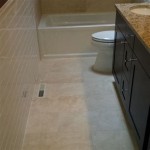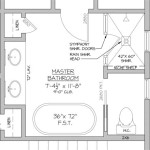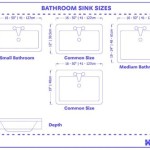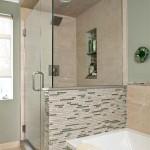How Much Does A Full Bathroom Renovation Cost?
A full bathroom renovation represents a significant undertaking for many homeowners. Beyond the aesthetic improvements, a well-executed bathroom remodel can increase property value and enhance daily living. However, understanding the financial implications is crucial before embarking on such a project. The cost of a full bathroom renovation varies widely, influenced by factors such as the size of the bathroom, the quality of materials selected, the complexity of the design, and the location of the property.
Numerous sources offer cost estimates for bathroom renovations. These figures, while helpful, often provide a broad range. This article will delve into the various components that contribute to the overall price, providing a comprehensive overview of the expenses involved in a full bathroom renovation.
Factors Influencing Renovation Costs
The ultimate price tag of a bathroom renovation is not a fixed number. Rather, it is the sum of various individual costs interacting with one another. Several elements significantly impact the overall expense. These elements can be broadly categorized into fixed costs that are difficult to avoid, and variable costs that can be adjusted based on individual budget and preferences.
Size and Layout: The square footage of the bathroom is a primary factor. Larger bathrooms naturally require more materials like tile, flooring, and countertop surfaces. A complex layout involving relocation of plumbing fixtures, such as the toilet, sink, or shower, will dramatically increase labor costs due to the re-routing of water supply and drainage lines. Conversely, maintaining the existing layout minimizes plumbing modifications and can reduce expenses.
Materials: The choice of materials dramatically affects the budget. Low-cost laminate countertops, basic ceramic tiles, and standard fixtures represent the budget-friendly option. Mid-range renovations might incorporate granite or quartz countertops, porcelain or natural stone tiles, and upgraded faucets and showerheads. High-end renovations frequently involve luxury materials, such as custom cabinetry, designer tiles, high-end plumbing fixtures with specialized finishes, and features like heated floors.
Labor Costs: Labor represents a significant portion of the total renovation cost. Hiring licensed plumbers, electricians, tile installers, carpenters, and general contractors all contribute to this expense. The complexity of the project, the number of tradespeople involved, and their hourly rates will determine the overall labor cost. Obtaining multiple quotes from qualified professionals is essential to ensure competitive pricing and to gauge the range of expertise available in the local market.
Plumbing and Electrical Work: Any alteration to the plumbing or electrical systems requires specialized expertise. Relocating plumbing fixtures or adding new outlets or lighting fixtures necessitates the involvement of licensed plumbers and electricians, respectively. Code compliance is paramount, and professionals will ensure all work meets current safety standards. Unexpected issues, such as outdated or damaged plumbing pipes or faulty wiring, can also arise during the renovation process, leading to additional expenses.
Fixtures and Fittings: The selection of bathroom fixtures, including the toilet, sink, shower or bathtub, faucets, showerheads, and lighting fixtures, plays a crucial role in determining the final cost. Budget-friendly options are readily available, while mid-range and high-end fixtures offer enhanced features, superior materials, and designer aesthetics. Special features, such as a jacuzzi tub, a steam shower, or smart-technology faucets, will significantly increase the budget.
Demolition and Disposal: Removing existing fixtures, tiles, and other materials involves demolition work. The cost of demolition may depend on the extent of the removal and the materials being extracted. Disposal fees for construction debris also contribute to the overall expense. Some contractors include demolition and disposal as part of their overall bid, while others might list them as separate line items.
Permits and Inspections: Building permits are typically required for bathroom renovations involving plumbing or electrical work, or structural changes. Permit fees vary by municipality and the scope of the project. Inspections are conducted by local authorities to ensure the work complies with building codes. Failure to obtain necessary permits can result in fines and delays. It is important to confirm with the contractor who is responsible for obtaining the necessary permits.
Breaking Down the Cost: Itemized Expenses
To get a clearer understanding of the financial breakdown, it's helpful to consider the common cost categories involved in a bathroom renovation. These categories provide a detailed view of where the money is being spent and allow for more precise budgeting.
Demolition and Disposal: This category typically accounts for 2-5% of the total renovation cost. It includes the removal of existing fixtures, tiles, flooring, and other unwanted materials. The cost will vary depending on the size of the bathroom and the complexity of the demolition work.
Plumbing: Plumbing work, including rerouting pipes, installing new fixtures, and connecting water and drain lines, generally represents 15-20% of the overall budget. The exact cost will fluctuate based on the extent of plumbing modifications required.
Electrical: Electrical rewiring, installing new outlets, adding lighting fixtures, and ensuring proper grounding usually accounts for 10-15% of the total cost. Electrical work is regulated stringently. Engaging a licensed electrician is a must.
Framing and Drywall: This pertains to adjustments to wall structures, adding walls, or repairing drywall. Depending on these efforts this usually contributes about 5-10% of the budget.
Flooring: Flooring installation, including the cost of materials and labor, typically makes up 10-15% of the total expenses. The selection of flooring material, such as tile, vinyl, or laminate, will significantly impact the price.
Tile: Tile work, including the installation of wall tiles, backsplashes, and shower surrounds, generally accounts for 15-20% of the overall budget. The type of tile, the complexity of the pattern, and the size of the area to be tiled will influence the cost.
Vanity and Countertop: The vanity and countertop represent a significant portion of the visible bathroom elements. This component usually covers 15-25% of the total budget. The choice of materials, size, and style of the vanity and countertop will affect the pricing.
Fixtures and Fittings: Fixtures and fitting such as toilets, sinks, showerheads, faucets, and lighting often represents 10-20% of the budget. The range of fixtures and fittings available can be quite large, impacting price.
Painting: Painting walls and ceilings is a relatively inexpensive part of the renovation, typically accounting for 2-5% of the total cost. However, the quality of the paint and the number of coats applied can influence the final price.
Miscellaneous Costs: A buffer for unexpected expenses, such as unforeseen repairs or changes in design, should be accounted for. This "contingency" fund usually contributes about 5-10% to overall cost.
Budgeting Strategies and Cost-Saving Tips
Managing the budget effectively is essential for a successful bathroom renovation. Careful planning, smart material selections, and a clear understanding of labor costs can help homeowners stay within their financial constraints. These strategies do not necessarily require sacrificing aesthetic quality.
Plan Thoroughly: Detailed planning is the most important step. Create a comprehensive design plan, including the layout, materials, fixtures, and finishes. This plan should include precise measurements and a clear vision of the desired outcome. The initial planning phase should also include a contingency plan for unexpected costs.
Obtain Multiple Quotes: Obtaining bids from several contractors is crucial. These quotes should be detailed and itemized, providing a clear breakdown of labor, materials, and other expenses. Comparing quotes allows homeowners to identify competitive pricing and assess the experience and expertise of different contractors. Thoroughly review the fine print of all contracts to identify any hidden fees or exclusions.
Prioritize Needs vs. Wants: Evaluate the renovation plan and prioritize essential upgrades over discretionary features. For example, replacing a damaged toilet is a necessity, while adding a high-end shower system might be a want. Focusing on core elements will help to maintain budgetary discipline.
Consider Material Alternatives: Explore cost-effective material alternatives. For example, consider using porcelain tiles that mimic the look of natural stone or granite countertops that offer similar durability and aesthetics at a lower price point. Researching material options can reveal budget-friendly choices without compromising visual appeal.
DIY When Possible: If you possess the necessary skills and experience, consider undertaking some aspects of the renovation yourself. This could include demolition, painting, or installing basic fixtures. However, tasks involving plumbing or electrical work should always be handled by licensed professionals to ensure safety and code compliance. Undertaking DIY work carries a level of risk, and may not be appropriate for all homeowners.
Time the Renovation Strategically: Consider the timing of the renovation. Demand for contractors and materials often fluctuates throughout the year. Avoiding peak seasons can potentially lead to lower prices and shorter lead times. Some contractors may offer off-season discounts or promotions.
Refurbish Instead of Replacing: In certain cases, refurbishing existing fixtures or cabinets can be a cost-effective alternative to replacing them entirely. This might involve repainting cabinets, replacing hardware, or refinishing a bathtub. Refurbishing can preserve the existing character of the bathroom while reducing overall renovation costs.
Avoid Major Layout Changes: A bathroom's layout significantly influences cost. Moving plumbing fixtures or altering the wall design requires a substantial amount of work. It is best to avoid altering the location of existing features.
Ultimately, a well-planned and executed bathroom renovation can significantly enhance the value and enjoyment of a home. A careful assessment of the scope of work, detailed planning, and diligent budgeting are essential for achieving a successful outcome. By understanding the various cost factors and employing effective cost-saving strategies, homeowners can navigate the various expenses that are involved in completing a bathroom renovation without breaking the bank.

How Much Does A Bathroom Remodel Cost 2024 Data Angi

Bathroom Remodeling Costs In Dc 2024 Sweeten

Bathroom Remodeling Costs In New Jersey 2024 Sweeten Com

Palmer Residential How Much Does A Bathroom Remodel Cost

Calculator How Much Does It Cost To Remodel A Bathroom

Bathroom Renovation Cost How Much To Budget For A Remodel

Bathroom Remodeling Costs In Chicago 2024

The Cost Of Bathroom Renovations In 2024

How Much Does Bathroom Renovation Cost In 2024 I Did It For 20 750

How Much Does A Bathroom Renovation Cost In Lendi
Related Posts







